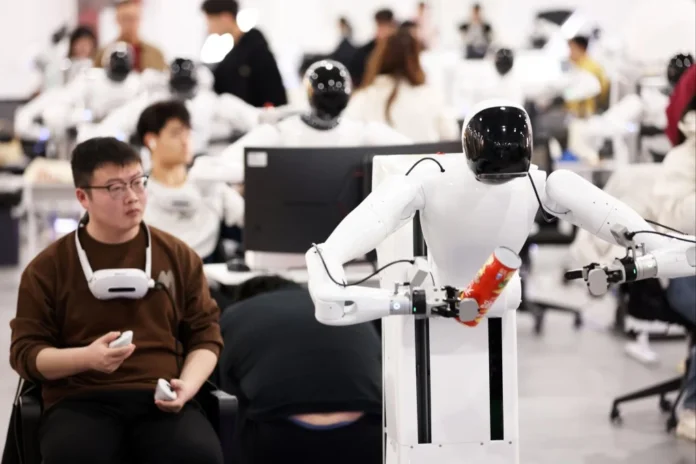In a bold move to secure dominance in the rapidly expanding humanoid robotics sector, China has launched the world’s largest humanoid robot training facility. The new center, located in Beijing’s Shijingshan district, spans more than 10,000 square meters and is designed to produce over six million data points annually—a crucial resource for advancing robotic intelligence and performance.
Mega Training Infrastructure to Power Robot Development

The newly inaugurated Beijing facility represents the most ambitious of several training centers being rolled out across China. Inside, 16 real-world simulation zones have been constructed, ranging from manufacturing workshops and retail outlets to elderly care centers and smart homes. These diverse scenarios allow humanoid robots to practice complex tasks and gather high-quality data essential for machine learning.
Shanghai has also joined the national effort with a 5,000-square-meter training hub that already hosts more than 100 robot models from over a dozen robotics firms. Once fully operational, it is expected to generate up to 50,000 pieces of data every day, significantly reducing the time and cost for companies developing humanoid robots.
Addressing China’s Robotics Data Shortage
Industry leaders emphasize that these large-scale facilities are crucial in overcoming China’s biggest obstacle—limited access to standardized training data.
Yang Zhengye, Director of Market Systems at Shanghai’s National and Local Co-Built Humanoid Robotics Innovation Center, highlighted that such hubs “solve the current data shortage that has constrained China’s robotics sector.” By centralizing data collection, the centers provide shared resources at a fraction of the cost compared to independent company initiatives.
China is also operating a 3,000-square-meter center in Shougang Park, Beijing, where more than 100 humanoid robots are already performing diverse assignments such as assembling machinery, cleaning facilities, and even watering plants. This site acts as a public technology platform offering data services to robotics startups and artificial intelligence companies working on embodied intelligence.
Strategic Rivalry with the United States
The timing of China’s expansion comes as the global race for humanoid robotics leadership heats up, particularly between China and the United States. American companies, including Tesla with its Optimus robot, are pushing aggressively to capture the market.
In a sign of its own ambitions, Tesla recently launched a dedicated social media account on China’s Weibo platform to showcase its AI-powered robotics technology. Analysts view this as a potential step toward competing directly in the Chinese market.
According to Morgan Stanley research, China’s robotics market is projected to surge from $47 billion in 2024 to $108 billion by 2028, reflecting an annual growth rate of 23%. By 2025 alone, Chinese companies aim to collectively manufacture more than 10,000 humanoid robots—representing over half of global production capacity.
Industry Growth Accelerates with Record Orders
Market momentum indicates that demand for humanoid robots is accelerating at an unprecedented pace. Estimates suggest that orders could surpass 30,000 units in 2025, a massive leap from the 3,000 units sold in 2024.
Leading robotics manufacturers—including **AgiBot, Unitree Robotics, and UBTECH Robotics—**plan to each produce more than 1,000 humanoid robots in 2025. Several landmark contracts have already been signed:
-
AgiBot has secured a deal with Fulin Precision worth $7–11 million to supply 100 industrial humanoid robots.
-
UBTECH Robotics announced a $35 million agreement, marking the largest commercial sale of humanoid robots to date.
Government Investment Fuels Expansion
China’s government is playing a pivotal role in boosting the sector through massive financial support. Over the past year, Beijing allocated $20 billion directly to humanoid robotics development while also establishing a $138 billion national fund to nurture artificial intelligence and robotics startups over the next two decades.
This level of funding significantly exceeds the investments currently seen in the United States and Europe, positioning China as the frontrunner in global humanoid robot production and deployment.
China’s Vision for a Robotic Future
With strategic investment, advanced training facilities, and a strong manufacturing ecosystem, China is fast-tracking the commercialization of humanoid robots. These initiatives are not only expected to transform industrial automation but also reshape services such as healthcare, elderly care, and retail.
Industry experts believe that by 2030, humanoid robots may become as common in workplaces and households as industrial robots are today. For China, establishing the world’s largest humanoid training facilities is not just about technological advancement—it is a statement of intent to lead the next industrial revolution.
Sources: SCMP


